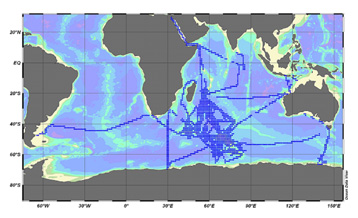|
Paris, February 13, 2009 The ocean less effective at absorbing CO2 emitted by human activityIn the Southern Indian Ocean, climate change is leading to stronger winds, which mix waters, bringing CO2 up from the ocean depths to the surface. This is the conclusion of researchers who have studied the latest field measurements carried out by CNRS's INSU(1), IPEV(2) and IPSL(3). As a result, the Southern Ocean can no longer absorb as much atmospheric CO2 as before. Its role as a 'carbon sink' has been weakened, and it may now be ten times less efficient than previously estimated. The same trend can be observed at high latitudes in the North Atlantic.
The increase in the amount of CO2 in the atmosphere, which is the
cause of climate warming, is the result of human activity (use of fossil fuels
and deforestation). However, warming is mitigated by the oceans and by
terrestrial ecosystems, which are able to absorb a large part of CO2
emissions. The oceans are the planet's main carbon sink(4), but in the last
ten years they have become increasingly unable to play this role, in both the
northern and southern hemispheres.
This is what has been discovered by Nicolas Metzl and his team at IPSL's
LOCEAN(5) laboratory. Their conclusion is based on data collected by the
OISO(6) Indian Ocean observation service, which was set up ten years ago with
the backing of INSU, CNRS, IPEV and IPSL in order to better evaluate
variations in the oceanic carbon cycle on seasonal to decadal scales. From
1998 to 2008, the OISO observatory carried out repeated campaigns of CO2
measurements in the Southern Indian Ocean between 20 and 60°S, on board the
ship Marion Dufresne(7). The data collected, together with earlier data
(1991-1995), show that the quantity of CO2 is increasing faster in surface
waters than in the atmosphere (by 2.1 microatmospheres/year in water as
opposed to just 1.7 in air). So although the CO2 content in the atmosphere
remains higher than that in surface waters, the difference is decreasing.
According to Metzl, who is leader of the OISO program, this increase is the
result of climate change at high latitudes, which has led to an increase in
the relative difference of atmospheric pressure at latitudes between 40 and
60°S, and therefore to higher wind speeds, leading in turn to increased ocean
mixing, with surface waters mixing with deep waters. Surface waters contain
less CO2
than deep waters, since CO2 is taken up by the photosynthetic
activity of marine phytoplankton. In addition, when these organisms die, they
are deposited in deep water where they are broken down by bacteria, thus
enriching the deep water in CO2. Thus when there is increased wind
mixing of the ocean, greater amounts of CO2 are carried from the
deep layers to the surface and, as a result, the ocean's ability to absorb
atmospheric CO2 is diminished..
This is the first time that field measurements have confirmed the role
of climate change in the oceanic carbon cycle in the southern hemisphere. The IPSL researchers used their data to estimate the efficiency of the oceanic carbon sink on a larger geographical scale, that of the whole Southern Ocean. They combined the data from the OISO program with other international oceanic CO2 data. Together with their colleagues, they revised downwards the amount of CO2 absorbed by the carbon sink in the Southern Ocean, in particular with the help of observations carried out during the southern winter. The carbon sink probably absorbs ten times less carbon than previously estimated: 0.05 gigatonnes of carbon/year (GtC/year) as opposed to 0.5 GtC/year.
Metzl and his colleagues also took part in analysing the oceanic CO2 sink in
the North Atlantic(8), combining data collected in the region since 1993(9)
with other international data. The conclusion is that the CO2 sink diminished
by 50% between 1996 and 2005 in the North Atlantic. The mechanism proposed by
the researchers appears for the moment to be connected more to fluctuating
weather conditions than to climate change(10).
Routes of the OISO observation service's oceanographic campaigns to measure CO2, carried out on board the Marion Dufresne between 1991 and 2007
This is because the models currently used for climate prediction do not correctly simulate the changes in oceanic CO2 observed over the last two decades at high northern and southern latitudes. Notes:1) Institut national des
sciences de l'Univers References:The results presented here are
a synthesis of three articles in Deep-Sea Res II, special issue SOCOVV
meeting, UNESCO/IOCCP, published online 8 February 2009. Contact information:CNRS researcher
|




